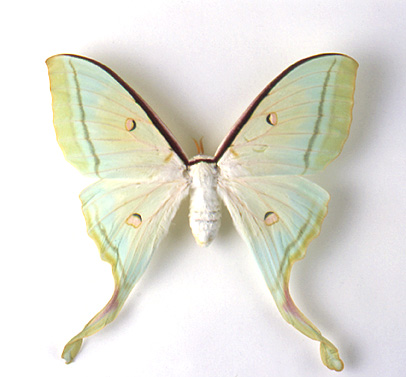Greater Indian Moon Moth (Actias selene)
Pricing: Dead (spread, as pictured): $75-$100 (spread)
Geographic Range: Oriental Realm
View: Top View Sex: Female Size: Wingspan: 13-17cm
Availability Notes: Not always available.

Image Copyright 2003
Barbara Strnadova
This incredible moth is quite widespread, found from India to Japan and then south into Nepal, Ceylon, Borneo, and other islands in eastern Asia. Many subspecies are described throughout it's range: A. selene brevijuxta from the Philippines (Nässig & Treadaway, 1997), A. selene eberti from Pakistan and Afghanistan (Rougeot, 1969), A. selene gnoma from Russia (Butler), A. selene ningpoana from China (C. Felder & R. Felder, 1862), A. selene seitzi from Java (Kalis, 1934), A. selene taprobanus from Sri Lanka (U & L H Paukstadt), and A. selene vandenberghi from Sumatra and Borneo (Roepke, 1956). Larvae in the wild prefer Rhododendron, but A. selene also accepts cherry (Prunus spp.), apple (Pyrus malus), Coriaria, Andromeda, Hibiscus, Salix, Malus, and Crataegus, to name just a few. Through much of its natural habitat this species is continuously-brooded with no winter diapause. However, it can survive extended periods of cold if it is not frozen. This allows hobbyists the ability to breed this moth throughout much of Europe and Asia. Chilling of autumn pupae can be used to prevent eclosion until the desired time. Temperatures above 27 C (80 F) will result in the emergence of adult moths in approximately three weeks (misting the cocoons helps). Eggs are 2 mm, colored white with extensive black and brown mottling. Incubation lasts approximately two weeks and newly hatched larvae are red with a black abdominal saddle. Second instar larvae are all red with black heads. It is not until the third instar that larvae take on a green color. The developing larvae prefer humid conditions.